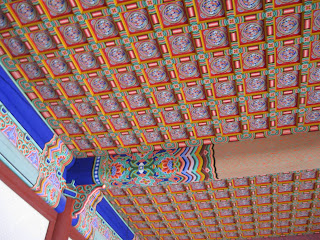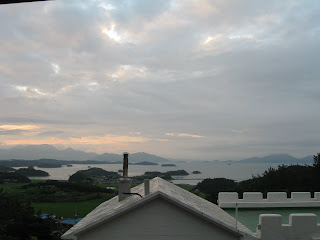Leslie's former roommate Susan has been in Seoul this summer teaching at a
hagwon. (It is emblematic of the high value that Koreans place on education that they send their children to these hagwons during summers, weekends, and evenings, in addition to their regular hours of schooling). Today we met Susan for the first time since we left Harvard, at one of the main tourist sites in Seoul — the former royal palace,
Gyeongbokgung ("Palace Greatly Blessed by Heaven"). Our first real trip on the Seoul metro (I'm not counting a ride of one stop that we did with a couple veteran APIS teachers who were showing us how the system works) went off without a hitch. The sun was really, dazzlingly, disorientingly bright when we stepped out from the subway, and the air was hot and humid. Leslie and I caught the tail end of a changing-of-the-guard ceremony at the front gate of the palace, and went to buy our tickets. Susan arrived just a couple minutes later.
We had agreed to meet at 3:00, which turned out to be good timing, because an English language tour was scheduled to begin at 3:30. The tour guide turned out to be the same one that Susan had had on her previous visit to Gyeongbokgung two years ago. We saw the ceremonial throne room, the room where the king conducted state business with his ministers, a pavilion (used only for state dinners) in the middle of an artificial lake, and the king and queen's living quarters (they lived separately, and neither the queen nor anyone else was allowed to sleep in the king's living quarters). The palace is beautiful, and there are fine views of the mountains just to the north; in places, you can almost forget you're in the huge city of Seoul. After we finished our tour, we went to the Gyeongbokgung café and ordered ourselves a traditional Korean dessert consisting of shaved ice, red bean, fruit, and
mochi, topped with ice cream. We went back to the subway, said goodbye to Susan when we changed lines, and returned home.
We arrived at Wolgye station ready for our "real" dinner. I had suggested eating out, so we walked a short distance to the busy street near our apartment, and passed a number of restaurants. We opened the door to one of them, decided it was too smoky, and walked on. We walked into another one, where the woman informed us that she wasn't serving food (although it's possible that she might just have been indicating that she spoke no English; I have my doubts). After peering into another restaurant, totally devoid of patrons on this particular Sunday evening, and attracting the attention of a young woman inside, Leslie and I decided to give it a try.
There were two Koreans in the restaurant, a man perhaps in his late twenties and the young woman who had seen us. They had (virtually) no English. We had (virtually) no Korean. They offered us
soju, a Korean alcoholic drink that tastes roughly like I imagine rubbing alcohol does, in which we were not interested; they offered us beer, in which I was somewhat more interested, although my wife was not. I held up one finger, to indicate the number of beers we wanted. They brought me a mug of beer and some munchies. Then they let us be. The man walked out the door. Leslie and I conferred. The Korean word for food, we were both pretty confident, was something like
pabul. We got the young woman's attention. I said, "Food?
Pabul?" and pantomimed spooning food into my mouth. The young woman laughed and went outside to retrieve the man. I repeated my performance for him. There was a picture of a fish on the wall. I pointed to it. "Tuna," said the man, along with a fair bit of stuff in Korean. Then he used the word
sashimi. (Leslie had already remarked that the restaurant seemed Japanese to her. The large picture of a sake bottle on the wall next to our table is what first tipped her off.) Leslie isn't a big fan of raw fish, so we hemmed and hawed. The Koreans spoke some more Korean. Then the man said "
Tempura?" We nodded.
The young woman brought us a salad consisting of greens, bean sprouts, and raw fish. (I initially thought that the fish was tomato. Leslie said it didn't look like tomato. I tried it, and I'm about 90% confident that she was right.) Then our waitress brought us bowls and spoons, dishes of soy sauce with a dab of yellowish paste on the side, and a metal contraption with five holes in the top. I examined said contraption closely, imagining that there might be some food hidden in it. "Are they going to light it?" suggested Leslie, and I noticed a wick inside. Satisfied that it was not at present a source of further nourishment, I set the contraption aside. Shortly afterwards, the waitress came back to light it. Flames came out of the holes.
Next, they brought us a steaming bowl of fish "tempura", which also included some kind of leafy, herby vegetable; long, thin mushrooms that we've seen several times at Korean restaurants (I had never seen them before I came to this country); some things that looked like rings of bread crusts; and (as we only discovered after eating for some time) a hard-boiled egg. We tucked in. There was a hole in the middle of the bowl, through which a flame from below frequently extended, making it hot work to reach in to the bowl with chopsticks. They helpfully brought us forks, which we did not use. The man came by and mixed the yellow paste into my soy sauce, grabbed a piece of fish from the bowl, dipped it into the mixture, and handed (or should I say chopsticked?) it off to me; he then went around and mixed Leslie's dish of soy sauce as well. The young woman brought us two small cups each shaped like half an egg, and said some words we didn't understand as well as the word sake. I drank most of mine and most of Leslie's, not wanting to leave them be in case they thought us rude, and not wanting to finish them off in case they brought us more. I didn't like it at first, but the more I drank, the better it tasted.
After a while, the man came and offered to take away the bowl. I wasn't done eating, but had no way of communicating that to him. Leslie suggested that he might want to extinguish the flame. I reached into the bowl for one more piece of fish, after which he removed the bowl. He did not extinguish the flame, and we were left alone for a while. Then he returned, with the bowl refilled. We were both nearly full by this time. We ate a little more, and Leslie expressed a wish of bringing it home. I expressed my doubts about taking soup out of the restaurant, and suggested that she take charge of communicating her desire. She countered that it was standard for Chinese restaurants in the U.S. to have styrofoam bowls with plastic covers to take soup out in. We stopped eating and waited for them to notice us. After five minutes or so, we took matters into our own hands. "Excuse me?" I said. Both of our hosts came to stand by our table. I indicated our happiness with the meal by giving them a thumbs-up and rubbing my belly. Then I told them that we wanted to take the soup home, which of course they did not understand. I picked the bowl up off the heating lamp and drew it to myself. I attempted to indicate the door. They got the drift pretty quickly. I thought the man was at first reluctant to comply with our request; but maybe he still didn't understand. In any case, they took the bowl back into the kitchen, and shortly afterward we saw the young woman emerge with our soup in a plastic bag, which she triumphantly held up for us to see. I gave her the thumbs-up. When she brought it to our table, I made the universally recognized gesture of reaching for my wallet. The man said a number in Korean, very slowly and clearly. This failing, the young woman resorted to producing a 10,000 won bill and a 5,000 won bill and displaying them to us. I pulled two such bills from my wallet and gave them to the man. We stood up. The man and I bowed to each other; Leslie and I said kam-sa-ham-nee-dah, which means thank you, and our hosts said the same.
As we were walking back to our apartment, Leslie asked if we should ever go back there again. "Of course!" I responded. "They are now our best Korean friends!" Excepting, of course, our Korean colleagues and our Korean boss.

















































